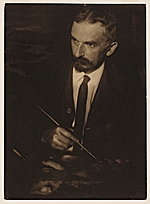I was introduced for the first time to the work of Arthur Wesley Dow in the spring of 2013.

I had taken a workshop with an artist who raved about Dow, and he encouraged me to buy Dow’s classic text on composition. From the moment I opened the book until I finished the last page, I realized that most of what I had been taught about drawing and painting was incomplete.
My personal bias towards most endeavors is structural in nature. I took a synthetic approach to most problem-solving issues and found that Dow too took a remarkably similar approach.
Composition
In the introduction of the book Dow says he chose the word Composition as the title because “that word expresses the idea upon which the method [he] presented is found – the “putting together” of lines, masses, and colors to make a harmony. Composition therefore is a building up of harmony and is the fundamental process in all fine art.
I could hardly believe what I was reading. For quite some time I had dabbled with line, notan and color. But I hadn’t understood how these three structural elements went together. Now I was beginning to put the pieces of the puzzle in their right order.
Dow had a simple (or so it seemed at first) four step process to developing his composition.
These are the four steps he presented
- Make a simple drawing
- Decide where the lights will go
- Tone the remaining ground in a mid tone
- Add the darks
This seems like a very straight forward process. And in the next post we will broaden the ideas and bring them to light.
A Simple Exercise
On a small note pad Draw a composition using only four shapes. Consider an outdoor scene with sky, ground plane, a distant hill, and some trees. Make a pleasing composition to your liking. Outline these big shapes in a thin line. Vary the composition in terms of length and width. Make several designs.
Til next time
Enjoy
Be sure to join our community for the latest content and other related ideas.
